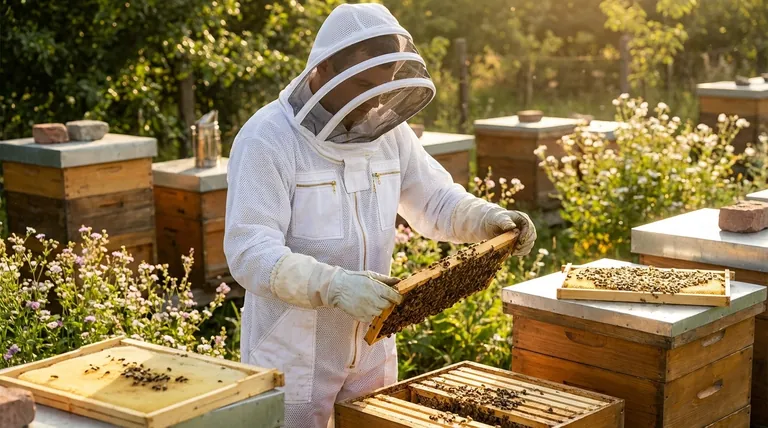When purchasing a ventilated bee suit, you must evaluate three core areas: the material and construction for sting protection, the fit and seal for preventing bee entry, and the design features that enhance comfort and usability. The best choice balances these factors to provide confidence and safety while you work.
Choosing a ventilated bee suit is an investment in your safety and comfort. The underlying goal is not just to avoid stings, but to be able to work calmly and confidently in your apiary. A well-constructed, 3-layer suit with robust seals is the most reliable path to achieving this.

The Foundation: Material and Protection
The material of your suit is the first and most important line of defense. It dictates not only how well you are protected from stings but also how comfortable you will be in the heat.
Why 3-Layer Mesh is the Standard
The most effective ventilated suits use a 3-layer mesh construction. This design is not just for airflow; it is a passive defense system.
The outer and inner layers of mesh create a significant gap between your skin and the outside of the suit. A bee's stinger is typically shorter than this gap, meaning it cannot reach you even if it penetrates the outer layer.
The Role of Stitching and Zippers
A suit's weak points are its seams and closures. Look for suits with heavy-duty stitching and durable zippers, often made of brass.
A failed zipper in the middle of a hive inspection is a significant safety risk. Strong, reliable zippers on the front, hood, and pockets are a mark of a quality suit built for longevity.
Ensuring a Bee-Proof Seal
A bee doesn't need to sting through your suit if it can simply crawl inside it. The most common entry points are the wrists, ankles, and the connection between the suit and the veil.
Critical Wrist and Ankle Closures
Effective suits provide secure seals at your extremities. Look for strong elasticated ankles that create a tight fit over your boots.
For wrists, thumb ties or loops are a critical feature. These loops keep the sleeve tucked securely inside your gloves, eliminating the gap that bees often exploit.
Veil Design and Integration
The veil protects your face and head, and its attachment point is a crucial seal. Many suits feature a detachable hood that connects with a full-circle zipper.
Ensure this zipper connection is robust and easy to operate. This allows for secure attachment and the convenience of removing the hood when you are away from the hive.
Understanding the Trade-offs: Price vs. Protection
While it can be tempting to save money, a bee suit is a piece of personal protective equipment where quality directly correlates with safety.
The Sub-$100 Suit Dilemma
Be cautious of suits priced significantly below the $100 mark. These often cut corners to reduce cost.
This can mean using thinner 2-layer mesh (offering less sting protection), employing flimsy plastic zippers that break easily, or having weak stitching that can fail under stress. A cheap suit can be a serious liability.
Ventilated vs. Traditional Cotton
The primary trade-off against a traditional cotton suit is cost. Cotton suits are less expensive but offer almost no ventilation, becoming extremely hot and uncomfortable.
The investment in a ventilated suit is an investment in comfort, which allows you to work longer and more calmly with your bees, reducing mistakes and stress.
Making the Right Choice for Your Goal
Select your suit based on your specific beekeeping context and priorities.
- If your primary focus is maximum safety and frequent use: Invest in a premium 3-layer suit from a reputable brand with reinforced brass zippers and integrated thumb loops.
- If your primary focus is comfort in a hot climate: Prioritize a fully ventilated 3-layer suit over partially ventilated models to ensure maximum airflow.
- If your primary focus is budget for infrequent inspections: A mid-range ventilated suit is a viable compromise, but carefully inspect the zipper quality and cuff elasticity before purchasing.
Your protective gear is a tool that enables confident and calm beekeeping.
Summary Table:
| Feature | What to Look For | Why It Matters |
|---|---|---|
| Material & Protection | 3-layer mesh construction | Creates a sting-proof gap; superior to 2-layer alternatives |
| Seals & Closures | Elasticated ankles, thumb loops, full-circle veil zipper | Prevents bees from entering through wrists, ankles, or hood |
| Durability | Brass zippers, heavy-duty stitching | Ensures long-term reliability and safety during inspections |
| Ventilation vs. Cost | Fully ventilated design vs. traditional cotton | Higher initial cost, but essential for comfort in hot climates |
Ready to equip your apiary with professional-grade, durable bee suits? HONESTBEE supplies commercial apiaries and beekeeping equipment distributors with wholesale-focused, high-quality ventilated bee suits built for safety and long-term use. Our suits feature the critical 3-layer mesh, secure seals, and robust zippers detailed above. Contact our team today to discuss bulk pricing and reliable protection for your beekeeping operations.
Visual Guide

Related Products
- 3 Layer Mesh Vented Sting Proof Beekeeping Suit with Hat and Veil
- Vented Beekeeping Jacket with Hood and Veil for Beekeepers
- Cotton Beekeeping Suit and Round Hat with Veil Bee Keeper Protective Gear
- Yellow Plastic Bucket Pail Perch for Beekeeping
- HONESTBEE Advanced Ergonomic Stainless Steel Hive Tool for Beekeeping
People Also Ask
- What are the advantages of reinforced stitching and durable zippers in beekeeping suits? Ensure Maximum Safety & Longevity
- Why do beekeepers wear suits? Essential Protection for Hive Management
- What features should be considered for sting protection in a beekeeping suit? Ensure Total Safety and Comfort
- What are the key features of the 3-layer mesh gear designed for beekeeping? Superior Protection & Ventilation
- What should be considered when fitting beekeeping clothing? The Essential Guide to Safety & Comfort



















